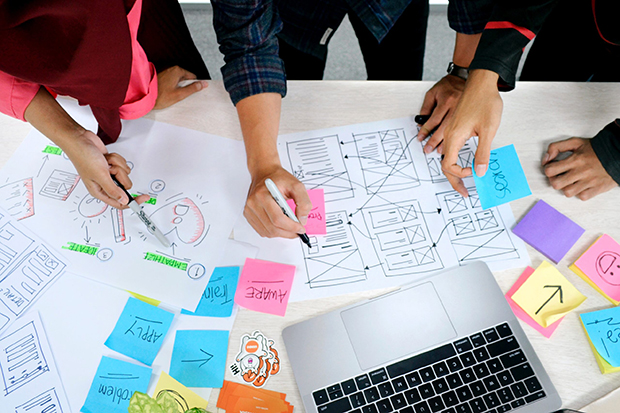Website Design vs. Website Development - 4 Differences that You Should Know About
Introduction

Hypothetically speaking, website development and website design almost seem like two children of the same mother. However, they are not identical twins. So, while you will find a similarity or two between them - they are largely different from one another.
In this article, we'll teach you about what web design and web development are, and how both of them differentiate from each other. But, before we do that, let's get you introduced to these two.
Website Design - What is It Really?
In Layman's terms, website design primarily focuses on the usability and the aesthetic of a site. For instance, the color scheme or the layout of a webpage can be considered two crucial facets of a website's appearance. And these can only be improved or beautified by a web designer.
What is their goal, though?
Well, a company specializing in website design in Singapore will mainly focus on creating a site that is visually digestible and appealing. Once that is done, they'll try to make it easier for a user to navigate through the same.
As the segment of website design is mainly focused on the visual aspects of a site, the designer is going to focus on the following:
- The logo design
- UX and UI design
- Color palettes
- Storyboards
- The format of the webpage
Does Website Development Do It Differently?
On the other hand, website development centers primarily on the mechanism of ensuring that the site is operating adequately. So, a web developer will be responsible for making the ideas of your web designer come true. And they will do so through masterful usage of coding.
However, unlike web designing, the developmental part of it is a bit tricky.
For example, there are two categories of development - back-end and front-end. Each of them does have a different set of requirements and, therefore, cannot be done by a single person.
A front-end developer, on the one hand, will solely focus on writing code to determine how the site will showcase the designer's concept.
Conversely, a back-end developer will focus on the aspects of data management in order to boost your database and showcase the same on the front-end.
How Do You Differentiate between Web Design and Development?
As stated before, there are quite a few differences available when comparing design and development. Let's keep reading to know more about it.
1 Definition and Purpose
Website Design
Website design primarily focuses on the aesthetics and user experience (UX) of a website. It involves creating the visual layout, choosing color schemes, selecting fonts, and arranging the elements on the web pages. The main goal of website design is to enhance the website's usability, ensuring that users can easily navigate through the site, find the information they need, and have a positive overall experience.
Website Development
Website development, on the other hand, deals with the technical aspects of building a website. It involves turning the design into a functional website using programming languages such as HTML, CSS, JavaScript, and more. Developers handle the backend and frontend aspects, ensuring that the website operates smoothly, loads quickly, and functions correctly on different devices and browsers.
2 Skill Sets and Roles
Website Design
Website designers are usually proficient in graphic design tools like Adobe Photoshop, Sketch, or Figma. They have a keen eye for aesthetics and usability and are skilled in creating visually appealing layouts. Designers also consider factors like user journey, wireframing, and prototyping to ensure an intuitive user experience.
Website Development
Website developers are proficient in coding languages and frameworks necessary to implement the design and create the website. They work with programming languages like HTML, CSS, and JavaScript, as well as server-side technologies like PHP, Python, or Node.js. Backend developers handle the server-side functionality, while frontend developers focus on creating the user-facing elements.
3 Collaboration and Workflow
Website Design
The website design process usually comes before development. Designers collaborate with clients or stakeholders to understand the brand, target audience, and specific requirements. They create mockups or prototypes that showcase the design concepts and work closely with clients to refine the visuals and get feedback before finalizing the design.
Website Development
Once the design is approved, developers take over the project. They use the design assets provided by the designers to start building the website's structure, functionality, and interactivity. Collaboration between designers and developers is essential to ensure that the final website maintains the intended design and user experience.
4 Focus and Objectives
Website Design
The primary focus of website design is to make a lasting impression on visitors and provide a visually engaging experience. A well-designed website enhances the brand perception and helps establish trust with users. Designers aim to create an intuitive and attractive interface that encourages people to stay longer on the site, explore its content, and ultimately take the required actions, such as making a purchase or subscribing to a newsletter.
Website Development
Website development's primary objective is to make the design functional and interactive. Developers work on optimizing the site's performance, ensuring it is responsive across various devices, and implementing features that enhance user engagement and overall functionality. They also take care of back-end processes, such as database management and server configuration, to ensure the website runs smoothly and securely.
The Bottom Line
While website design and website development are different aspects of the website creation process, they are interconnected and equally vital for building a successful web presence. Effective collaboration between designers and developers is essential to create a website that not only looks visually appealing but also functions seamlessly to provide an excellent user experience. Understanding the distinctions between these two disciplines will enable businesses and individuals to make informed decisions and achieve their online objectives effectively.
Copyright © . All Rights Reserved